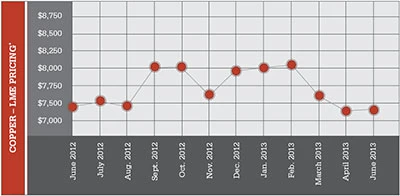
Moving into the summer months, signs of upward momentum in nonferrous scrap markets are nonexistent. The sense is growing that markets for copper, aluminum and other nonferrous metals will continue to remain flat. Several sources say more buyers are competing for available scrap, making business more challenging.
The extended price slump, which began in early 2013, runs counter to more traditional markets, when price and demand have perked up during the first quarter of the year.
One source in the eastern half of the country says that while markets in the first quarter of the year were not robust, much of last year was positive for nonferrous metals, and the slower markets are part of a downward adjustment.
Another source, who splits his nonferrous orders between offshore and domestic markets, agrees that aluminum and copper prices have been on a steady slide since this January, despite a fairly stable domestic manufacturing sector.
Another nonferrous scrap dealer who specializes in copper describes a mediocre market. “There are sporadic orders, and the supply is there, although we have to work a bit harder to get the material,” he says.
.jpg) *Average monthly settlement price, cash buyer; U.S. dollars per metric ton. Source: London Metal Exchange, www.lme.com |
According to conventional wisdom, the supply of marketable scrap has declined. However, several other scrap dealers say that rather than a decline in available material the tightness in supply is a result of increased competition for available material, which also is leading to narrower margins for processors.
One East Coast scrap metal dealer says large, publicly traded companies are aggressively paying more to secure material, which is putting additional pressure on independent scrap metal recycling firms.
Several sources say operations are good overall, with the aerospace and transportation sectors growing at a decent clip. Meanwhile, the housing sector, a key economic indicator, has been showing signs of life.
Copper, which seems to be driven by general pessimism, may have found a floor, at least temporarily. However, even that potential positive sign is said to result from problematic mine operations that have cut into supply. A recent mine collapse in Indonesia, for example, has curtailed operations temporarily, creating a ripple effect in secondary markets.
While the United States seems to be showing modest signs of improvement, challenges continue for those shipping to Europe and China. European economies continue to struggle, and China’s economy, which had been growing at double-digit rates, has cooled.
The copper and aluminum market in China also are under significant pressure, as their sharp ramp up in production is running up against slowing domestic demand. The result has been significant cuts in production.
The aluminum overcapacity problem isn’t limited to China, however. Rusal, the largest aluminum producer in the world, also has announced plans to shutter around 4 percent of its manufacturing capacity. Other large and mid-sized aluminum producers also are taking steps to reduce their aluminum production to better align with demand.

Explore the July 2013 Issue
Check out more from this issue and find your next story to read.
Latest from Recycling Today
- Proposed bill would provide ‘regulatory clarity’ for chemical recycling
- Alberta Ag-Plastic pilot program continues, expands with renewed funding
- ReMA urges open intra-North American scrap trade
- Axium awarded by regional organization
- China to introduce steel export quotas
- Thyssenkrupp idles capacity in Europe
- Phoenix Technologies closes Ohio rPET facility
- EPA selects 2 governments in Pennsylvania to receive recycling, waste grants





